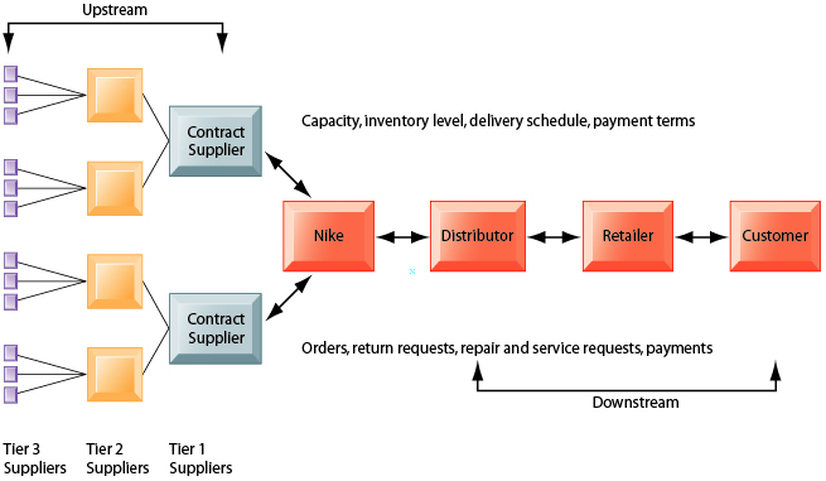Introduction to the Supply Chains of the Future in Sports Merch
Sports merchandise is a booming industry, with the global sports apparel market projected to reach an impressive $208.9 billion by 2025. Part of this revenue growth is tied to how efficiently businesses can get their merchandise to consumers. More and more, buyers are curious about how and where their products are made.
According to one recent study, 81% of sports apparel companies reported that supply chain transparency influences consumer purchasing decisions. This increased focus on openness and fast delivery drives the need for supply chains of the future to be agile, tech-enabled, and sustainable.
When we talk about “supply chains of the future,” we are referring to the advanced processes and innovations that will shape how products move from inception to final delivery. The sports footwear market alone is expected to grow at a CAGR of 4.1% from 2021 to 2028, partly because of better supply chain strategies.
For the casual athlete and the weekend warrior, future supply chains mean more personalized gear, quicker turnaround times, and greater trust in the sourcing process. This post will explore seven key technologies that power these cutting-edge networks, and why they are essential to ensuring sports merch remains at the forefront of performance, style, and sustainability.

Seven Key Technologies Shaping the Supply Chains of the Future
The future of sports merch relies on innovations that streamline production, minimize costs, and promote sustainability. Below, we explore seven transformative technologies making headlines in the push for the supply chains of the future.
1. Artificial Intelligence (AI)
AI is helping businesses predict product demand, manage inventory, and optimize logistics routes. Recent data shows that the use of AI in sports supply chain management is anticipated to grow at a CAGR of 45% through 2027. For sports merchandise companies, AI-driven analytics can suggest the right amounts of jerseys, caps, and shoes to produce—while minimizing waste. This greater efficiency benefits not only big players but also smaller community leagues that now have access to more accurate order fulfillment.
On the consumer side, AI supports personalization. Sports fans can design custom jerseys that are produced on-demand, while team managers can manage orders with less guesswork. The result is a more flexible model, which accommodates varying levels of demand throughout the sports season. Flexible supply chains of the future are especially important given the rising global demand for personalized sports apparel.
2. Blockchain
Blockchain’s decentralized ledger system is transforming how products are tracked along the supply chain. The fastest-growing segment in sports merchandise supply chain is licensed merchandise, with a CAGR of 6.2% from 2020 to 2025. As businesses look to protect brand identity and trademarked logos, blockchain’s transparent records make verifying authenticity easier.
Because blockchain keeps a verifiable log of every transaction, companies can trace the origin of raw materials (like fabrics or rubber) and ensure that production meets ethical and environmental standards. Tools like IBM Blockchain Transparent Supply help to reduce counterfeits and build consumer trust. Whether you’re a city league coach or a weekend tournament organizer, knowing your sports merch was responsibly sourced fosters confidence in the final products.
3. Internet of Things (IoT)
IoT devices like smart sensors and RFID tags are becoming common in modern warehouses to track inventory in real time. By attaching sensors to shipping containers or individual sports items, companies receive continuous data on location, temperature, and other factors that might affect product quality. This is vital for time-sensitive materials such as moisture-wicking fabrics or custom printed items that need precise handling.
Through IoT-enabled tracking, sports retailers can better anticipate delivery times, preventing shortages of popular items during peak seasons. Additionally, the sports apparel industry is projected to increase its supply chain investment by 14% in 2024 to enhance agility and responsiveness—capabilities that IoT makes possible.
4. Robotics & Automation
Warehouses today use robotic systems to pick and pack orders with precision and speed. Automated conveyors, sorting machines, and robotic arms significantly reduce human error and speed up the fulfillment process. As supply chains of the future become more reliant on daily or even hourly deliveries—especially in fast-moving sports merch markets—repetitive tasks become prime targets for automation.
Robotics also ensures consistent quality control. For example, an automated system might catch a printing defect on a run of jerseys before they ship. This reduces returns and boosts customer satisfaction. And with drone technology in sports supply chain logistics projected to increase by 35% annually through 2026, we may soon see drones assisting inventory checks at large warehouses or even delivering small packages directly to local sports clubs.
Additional Key Technologies
Beyond AI, blockchain, IoT, and robotics, there are three more important technologies shaping the supply chains of the future:
- 3D Printing: Allows for rapid prototyping and on-demand production of custom gear.
- Big Data Analytics: Helps managers analyze massive datasets to spot trends and make smarter buying decisions.
- Cloud Computing: Offers scalable storage and real-time collaboration regardless of location, useful for global sports merch suppliers.
Practical Tools for Building the Supply Chains of the Future
Building robust supply chains of the future requires the right platforms and applications. Small teams, local leagues, and larger sports businesses can all benefit from specialized software designed to manage production, demand, and shipping:
- SAP Integrated Business Planning (IBP): A cloud-based system unifying sales and operations planning, so you can make data-driven decisions.
- IBM Blockchain Transparent Supply: Elevates transparency and security by leveraging blockchain to track every step of your product’s journey.
- Oracle Supply Chain Management (SCM) Cloud: Offers end-to-end solutions, from product development to order fulfillment, ideal for growing sports brands.
- Microsoft Dynamics 365 Supply Chain Management: Enhances resilience and visibility, making it simpler for team managers to keep tabs on orders and reduce bottlenecks.
- Infor Nexus: Connects suppliers, manufacturers, and logistics providers, helping even smaller leagues benefit from collaborative, real-time data.
These tools aren’t just for massive apparel giants; local rec leagues or small businesses looking to sell branded shirts or caps for a community event can also glean insights.For teams and mid-sized brands, working with sourcing partners like Sphere Resources can bridge the gap between advanced platforms and on-the-ground supplier management. In particular, flexible solutions can adapt to different volumes, whether you’re distributing a thousand jerseys or just a few customized items for a local team.

Leading Players Transforming Supply Chains of the Future
Several organizations stand out for pushing boundaries and modernizing the supply chains of the future in sports merch. Let’s highlight some key companies:
- Nike, Inc.: Known for sustainable innovations and agile manufacturing approaches. Nike explores AI-driven demand forecasting and invests in advanced automation to maintain its edge.
- Adidas AG: Focuses on supply chain transparency through blockchain pilots and invests heavily in recycled materials for a more sustainable supply chain.
- Under Armour, Inc.: Uses AI tools to predict demand and advanced manufacturing methods for performance-focused gear. Their aim is to reduce lead times while personalizing apparel.
- Fanatics, Inc.: A top provider of licensed sports merch. Fanatics relies on robust e-commerce technology and streamlined logistics to quickly get fans the gear they want.
- Puma SE: Prioritizes sustainability by auditing supplier practices. Puma experiments with omnichannel supply chain models, aligning with trends showing 69% of sports retail brands expand in this area.
Other innovators include Wincraft, Inc., which produces licensed sports merchandise and invests in advanced technology for quick turnaround, and IBM Corporation, whose blockchain solutions set new industry standards for cybersecurity. Given that 81% of sports brands plan to increase investments in supply chain cybersecurity measures by 2025, proactive players in this field are well-positioned to remain leaders in sports merch.
Recent Trends Driving These Innovations
Across the industry, four major trends help shape the technologies and strategies for supply chains of the future:
- Adoption of Blockchain Technology: Enhances traceability and helps authenticate branded items.
- Integration of AI: Optimizes demand forecasting and logistics, driving down costs.
- Emphasis on Sustainability: Grows from consumer demand and regulatory pressures to reduce carbon footprints and plastic waste.
- Expansion of E-commerce Channels: Feeds consumer expectations for fast shipping and easy online ordering, driving omnichannel supply chain strategies.
Companies that adapt to these trends can respond faster to shifts in consumer tastes, be it the sudden popularity of a new sports star or a jump in demand for sustainable apparel.
Conclusion
Building the supply chains of the future in sports merch isn’t just an abstract goal—it’s becoming a practical necessity for brands, retailers, and even local community teams. Technologies like AI, blockchain, IoT, and robotics are already making a significant impact by boosting transparency, reducing lead times, and improving customer satisfaction.
As the sports apparel industry invests more in flexible and sustainable models, fans and players alike benefit from better-quality goods that align with their values.
From the global sports apparel market expected to reach $208.9 billion by 2025, to licensed merchandise that’s growing at a notable clip, the industry clearly shows no signs of slowing down. Moreover, the push for a sustainable supply chain resonates with a new generation of eco-conscious consumers.
Pursuing supply chains of the future ensures that sports merch—from amateur leagues to celebrated professional teams—remains a reliable, high-quality option for athletes and fans worldwide. By staying ahead of these trends and adopting the right technologies, every organization, big or small, can thrive in the evolving world of sports merchandise.

